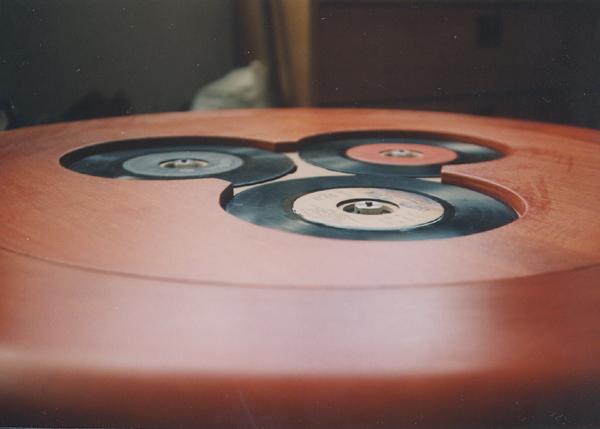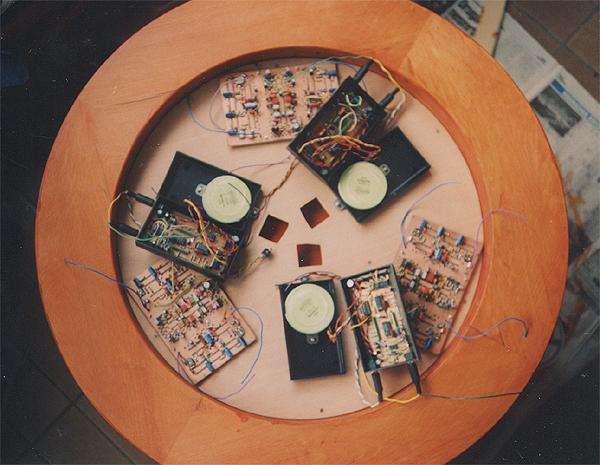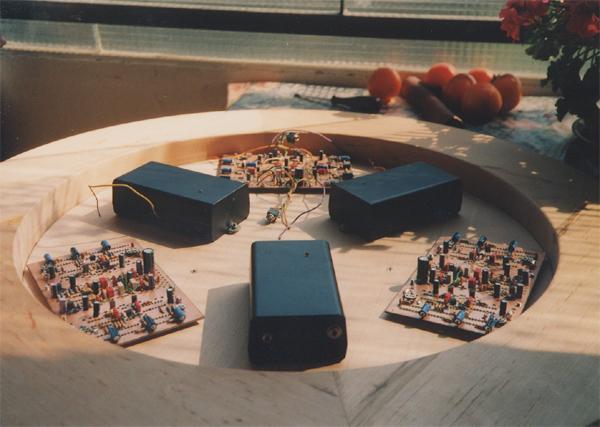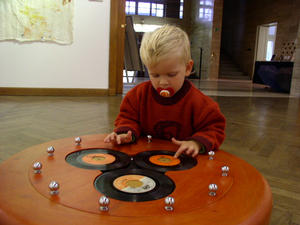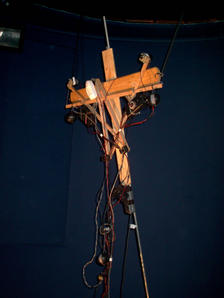Okrogla miza / Round Table
Na Kunstradiu, Dunaj junija 2002
Thanks for photos!
Okrogla miza spada med takoimenovane metaforične objekte*, s katerimi želim na nek način objektivirati / “povnanjeno strukturirati” nekatere razmisleke o sebi in zunanjem svetu. Zanimivo pri gradnji takšnjih objektov je, da sami med procesom gradnje ponudijo še kopico dodatnih relacij, ki se jih misli niso dotaknile – pogosto pa miselni načrt (koncept) celo postavijo na laž / na glavo. Tudi v tem primeru se zdi, da je to del harmonizacije / uskladitve želja / načrtov z okolico – pri tem to okolico pogosto predstavljajo fizikalni zakoni.
Okrogla miza pa je tudi moj prvi “večji” objekt, ki se je v preteklih letih (od leta 2001) osamosvojil in popustil pod običajnimi družbenimi relacijami in načini predstavitve. Pri tem imam v mislih predvsem galerijski / razstavni način predstavitve in banalizacijo na zgolj vizualni objekt. Seveda v tem primeru brez ustreznih podnapisov za gledalce ni vpogleda v razloge in ideje, ki so botrovali izgradnji takšnega sistema, zato tudi ne more biti vseh plasti razumevanja. Brez takšne izraznosti je objekt dvomljive umetniške vrednosti in lahko v najboljšem primeru ostane živ le še kot zvočni instrument.
Umetniškost se na nek način vedno izmakne, ko pride do možnosti “uporabnosti” predmeta. Še sreča, da miza ne more igrati glasbe s plošč in se na tej ravni odmika od splošnejše uporabnosti! Na ta način ohranja določeno stopnjo avtonomije / lastne povednosti – govori svojo zgodbo v sebi lastnemu jeziku. A za širše razumevanje je potrebno povedati še zgodbo o nastanku.
Idejna zasnova
Posredni povod za gradnjo je dala Susanna Niedermayer, ko je bila še sodelavka programa za eksperimentalno glasbo Kunstradio na avstrijskem nacionalnem radiu ORF. Ob predlogu, da bi predstavil kakšno zvočno delo je bil pogoj le ta, da naj bi bilo delo v obliki enega od radijskih žanrov. Tedaj se je rodila ideja o dobesednem razumevanju naziva žanra, torej “okrogla miza”.
Okrogla miza predstavlja prostor pogovora, usklajevanja – je simbolni prostor enakovredne komunikacije (ni nobenih vogalov, ni spredaj/ zadaj,…). Jasno je bilo tudi, da pri izmenjavi mnenj ne bo šlo za običajno izmenjevanje besed, ampak abstraktnejših pojmov – zvokov. Na nek način je bilo potrebno vgraditi tudi nezmožnost soliranja – torej: neogibne povezanosti in prepletenosti izraznih pojmov. Miza naj bi namreč predstavljala kristal, v katerem so že zajeti vsi odnosi, do katerih potem (na neki drugi stopnji) prihaja tudi med udeleženci “muziciranja”. Struktura seveda že določa vrsto relacij in možne načine komuniciranja.
Ker je radijski prostor javni prostor se je kot ustrezna metafora pri objektu pojavila nuja po definiranju minimalnih pogojev za nastanek javnega prostora. Instrument sem oblikoval za tri ljudi, s tremi osnovnimi podsistemi, ki so med seboj prepleteni (drugi modul “posluša” prvega in tretjega, ter “govori”/ pošilja signale prvemu in tretjemu). Da bi tako zgrajena Okrogla miza postala / ostala simbolni objekt, je bilo potrebno vgraditi neenostavne (nelinearne) načine odzivanja. Ta metoda se že spogleduje z lastnostjo avtonomije, za katero bi morda lahko rekli, da potrebuje vgradnjo nekega algoritma. Ker nismo želeli posegati po računalniku, smo se raje domislili zelo posrednega proženja dogodkov. S pomočjo senzorjev (preprosti radiofrekvenčni generatorji zvoka – “teremini”) nadziramo nekatere parametre, kot so proženje in sukanje treh motorjev s ploščami, in spreminjanje tonskih lastnosti in jakosti zvoka, ki prihaja s treh plošč. Marsikaj, kar se tiče prepletanja v tej plasti je ostalo nedorečeno / neizvedeno.
Zadnja stopnja razmisleka pri gradnji je bila povezana z možnimi simbolnimi interpretacijami – zlasti kar se tiče načina igranja (uporabniški vmesnik / “interface”), ki odseva “uporabnost” objekta, s katerim postane ta del “kulture / folklore”. Klaviatura, kot del kulture 19. stoletja je na primer nek tak kodiran sistem muziciranja, ki odseva kulturo tedanjega časa. Ali pa malo kasneje simfonični orkester, ki z enim vodjem morda kaže na vero v sistem z velikim voditeljem na čelu organizacije.
No, za nas je bila zanimiva misel o igranju s pomočjo gibanja rok tik nad mizo. Ta “eterični” način igranja se sklada z etrom, kot arhaičnim umevanjem sevanja radijskega oddajnika, hkrati pa spominja na neke vrste spiritistično seanso (zanimivo, tudi ta je bila zabava meščanskih slojev v 19. stoletju). Torej bi bile možne interpretacije lahko: da gre za prizivanje duhov, za ojačevanje duhovnih moči s pomočjo sklenjenega kroga “glasbenikov” – v prenesenem pomenu pa za klicanje “duha umetnosti” – naj se vendarle zvočni tok pojavi v “estetski obliki” – kot umetnina. Umetnik kot sodobni šaman, prizivalec duhov, vezni člen med materialnim in duhovnim,… To nam je že znano, a je v našem kontekstu povedano tudi s kančkom ironije.
Okrogla miza je torej v fazi projektiranja spregovorila dovolj zgodb, povezala v eno dovolj relacij, da je upravičila izgradnjo. A kako potlej? Objekt brez pomena / uporabnosti, brez prvotnega konteksta (idejne zasnove), ostane le goli kos materiala, ki se lahko v najboljšem primeru nahaja v kakšnem kotu katerekoli od mnogih razstav. Po Dunaju, Ljubljani (Galerija Kapelica, Klub Gromka, Menza pri koritu), Zagrebu in Beogradu je tokrat pristal v Moderni galeriji. Zdi se, da je marsikje še vedno kazal znake življenja, predvsem so ga imeli radi otroci, pa tudi kakšen za ekstatično odprti posameznik.
Navodila za uporabo:
Sami, ali v dvoje, troje, sedite k Okrogli mizi, z nešnimi dotiki kovinskih kroglic ob robu mize prisluhnite zvočnim spremembam, s kombinacije dotikov večih kroglic hkrati pa skušajte slediti tako nastajajoči zvočni strukturi. Povečujte intenzivnost in površino dotika kože in kroglic ter sledite zvočnim spremembam. Z določeno mero pozornosti je mogoče doseči dovolj kompleksno strukturo, da ta zadovolji “muzikanta”. Pri tem našim otopelim čutom izdatno pomaga večja glasnost zvoka.
Naslednja stopnja bi lahko bila hkratna manipulacija (ročno zadrževanje in sukanje) plošč, kar lahko prispeva modulacijo zvoka. Najvišja stopnja muziciranja je v dvoje ali troje. Izkušnje kažejo, da morajo glasbeniki najprej slišati svojo “zvočno podobo”, šele po tej (samo)identifikaciji pa so pripravljeni na kolektivno igro (poslušanje drugih in kreiranje skupnega) – komuniciranje.
Zanimiv pojav pri muziciranju je, da glasbenika narava zvokov sploh ne moti, razmeroma zlahka prodre v strukturo, drugače pa je za pasivnega poslušalca. Razlogi za to so v tem, da miza producira povsem svojo strukturo, v katero se lahko (zaradi precej neposredne odzivnosti Okrogle mize) aktivni uporabnik zlahka umesti, pasivnega pa zvoki ne zapeljejo.
Borut Savski
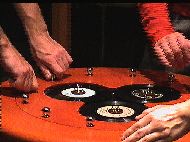
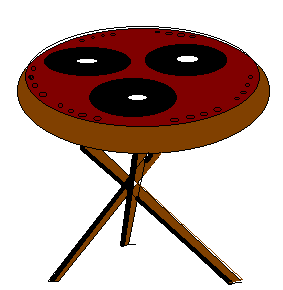
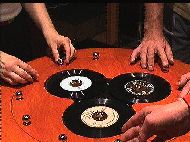
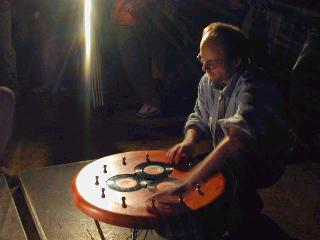
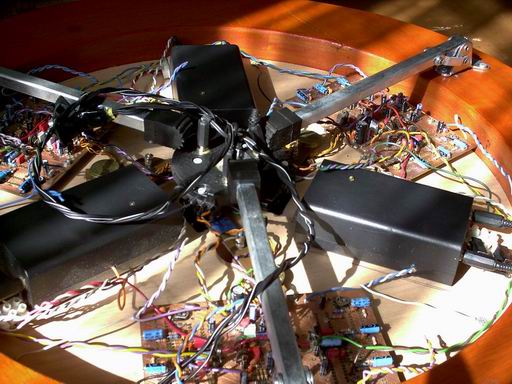
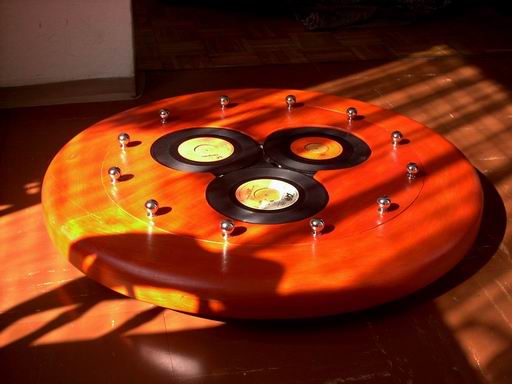
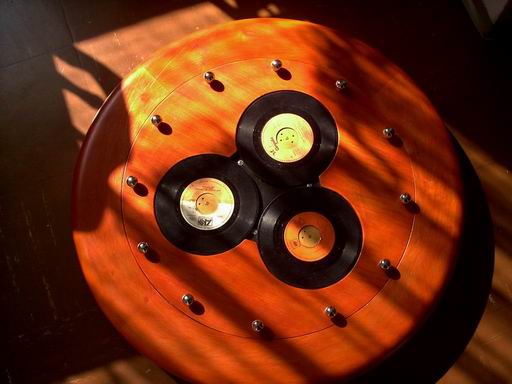
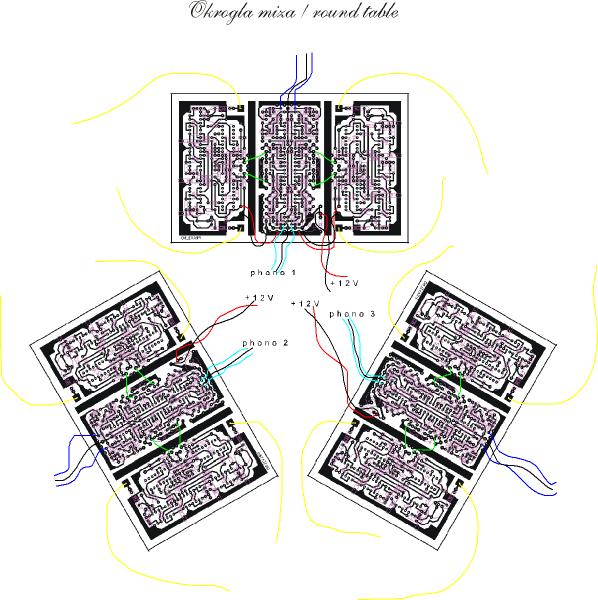
*Metaforični objekti | *Metaphorical objects
Če se strinjamo, da ljudje razumemo svet okoli sebe in samega sebe s pomočjo namišljenih / miselnih objektov, torej kot sintetizirane / strukturirane zgradbe / stroje, potem je lahko razumeti, kakšen je princip, ki me vodi pri gradnji metaforičnih objektov. Najprej travmatična izkušnja ali paradoks / problem / neskladje, nato razmislek o razlogih in o pomenih, ki bi lahko na novo pojasnili / opisali porušena razmerja – torej harmonizacija / strukturiranje / sinteza. Rezultat je ponovno (a le začasno) trdna zgradba – trdna podoba o svetu / zakonitost. Novo pojasnjeni pojmi želijo biti univerzalni in zato nastopijo v kakršni koli zgodbi / izpeljavi / zgradbi. Temu lahko rečemo racionalizacija.
Prenos reduciranega števila (zame) nabolj pomembnih pojmov v kakršen koli drug prostor (na primer: umetniški medij) naj bi bila osnova umetnosti (od 20. stoletja dalje) – naslikati podobo sveta. Nekaj doslej oblikovanih / zgrajenih metaforičnih objektov je prikazanih spodaj.
Pod nazivom estetski stroji predstavlja druga slika spodaj vmesnik (“interface”) za sinhronizacijo / organizacijo štirih ljudi. Komunikacijski kanal (-> smisel) je zvok, ki se ga ustvarja s pomočjo drgnjenja klavirskih žic. Teme: individualno / kolektivno; razgrnitev / napenjanje prostora (kot rjuhe) ga šele odpre. Odpre se prostor opozicij, dualizmov – to je opisni prostor / vrednostni sistem. Nerazgrnjen prostor je kaos, nič (ali vse, a brez vidnih odnosov). Le razgrnjen / organiziran / osmišljen prostor je v človeški domeni – struktura ali simbolni prostor. “Bazooka” (Orožje / orodje) je metafora prosotra / konteksta in sprememb pomena, ki ga vsilijo vsakemu na novo vnešenemu objektu / konceptu – kontekst spremeni odnose. Električni Jezus kot simbol / metafora za uravnovešanje sveta s pomočjo trpljenja (pasion) – tehtnica s premikom prečke postane križ, Jezus (trpljenje) pa skrbi za uravnovešanje dobrega & zla (in sploh vseh opozicij / dualizmov). Bog nasproti človeku (-> Go[o]d : M[e]an?). Dobro nasproti zlu. Orakelj je proces dekonstrukcije mita / simbolnega predmeta in ponovne rekonstrukcije kot umetniškega objekta. Slednji naj bi mit demistificiral, saj so razlogi / ideje, ki so mitu botrovali na površini nevidne. Tako kot asociacije je mit samostojen, emocionalno nabit objekt – univerzalni stroj, ki govori veliko različnih zgodb. Hiter prevajalnik za proizvodnjo pomena. Plesalec vsebuje vprašanja of dinamičnem (samo)uravnovešanju in o avtonomiji (tudi o svobodi, svobodni volji in odločitvah). Moja teza je: Odločitve so poljubne – gibanje (odločanje; procesi) je edino važno…. Naše psihološke lastnosti (manko) je motor / motivator. Električni Jezus 2 je ena zadnjih izvedb in razširi prostor idej Jezusa št. 1 z nekaterimi drugimi koncepti (avtonomija, zaznavanje, pretvorba premikov na neenostaven / netrivialen način, ideja o samopremikanju, itd.). Performensi / instalacije The Eye = I pa odpirajo razmislek o distribuiranih / razmaknjenih sistemih / identitetah. Le kaj naredi iz posameznih delov “celoto”? Odgovor: Mi.
If we can agree that us humans understand the world through imaginary / mind objects, as synthesized / structured buildings / machines, then it is easy to understand the principles that lead me to constructing the metaphorical objects. First a traumatic experience or a problem / paradox / disagreement, then rationalization / thought process about reasons and meanings, that could explain / describe the broken relationships in a new and more successful way – a kind of harmonization / structuring / synthesis. This is usually called a rationalization.
The result is always (but only temporary) firm building – a firm image of a world / the law. Newly defined expressions / relations tend to be universal and are therefor parts of any story / explanation / structure. A transfer of a reduced number of the most important (subjectively) expressions in any kind of different space (for example: art medium) is supposed to be the basis of art (from the 20th century onwards) to picture the image of the world. Metaphorical objects come in various flavours, as shown below.
Described as aestethic machines, the second image below shows an interface for four people to synchronize on making music with piano wires – individual / collective; expanding the space = putting it under tension, openes it up. Folded space is chaos, nothing (or all, but without any relations visible). Only unfolded / organized space is the human domain – the structure. “Bazooka” (Arms or Tools) is a metaphore of space / context and the changes to the meaning to the newly introduced object / concept – the context changes the relations. Electric Jesus as a symbol / a metaphore of balancing the world through passion / suffering – the scale becomes a cross and Jesus (the suffering) takes care of the balancing between good & bad (and all values that are in opposition – duality). God in opposition to Man (-> Go[o]d : M[e]an?). The Oracle is about deconstruction / reconstruction of a myth / symbolic object – the ideas that formed a myth are not visible on the surface of such an object. What you see is what you get: as any association it is emotionally full – a machine telling many (different) stories. A machine (a quick program) for translation of meaning. The Dancer is again the art of dynamic balancing, and autonomy (also the freedom, free will). A thesis: our decisions are arbitrary – the movement is all that matters… Our (split) psyche is the motor / motivator. Electric Jesus 2 is the recent idea and expands ideas from no.1 with some other concepts (autonomy, sensing, translation to movement, the idea of self-lifting, etc). The Eye = I performances/ installations point to the idea of a distributed self (or any identities) – what makes up “the whole”. The answer: We do.
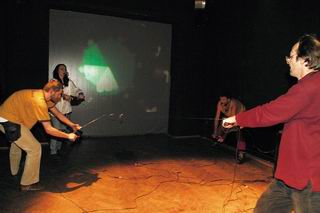
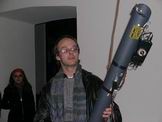
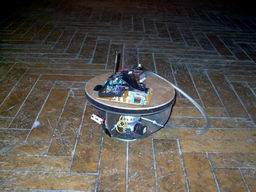
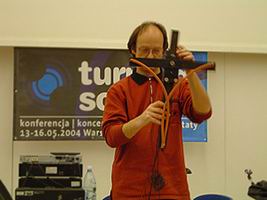
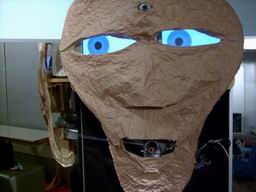
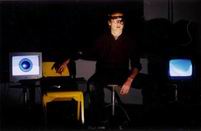
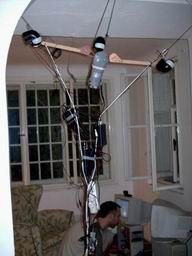
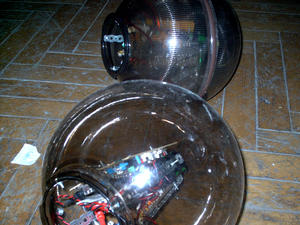
The Round Table is a part of so-called metaphorical objects*, which help me to objectify / to “structure externaly” some thoughts about myself and the world. A very interesting thing with such a method is that the objects during the building offer a great number of additional relations, that did not emerge through the thought process – and very often the thought process is put to a lie / a kind of paradox.. This is usually also a part of harmonization / adaptation of plans / wishes / preconceptions with the surroundings – this surrounding is often represented as the laws of physics.
The Round Table is also the first of such “larger” objects, that in the recent years (since 2001)took on its own and yielded under the usual social relations and modes of representation. Here I mean especially the gallery / exhibiting mode of presentation and the reduction / banalization to a solely visual object. Of course in the case of metaphorical objects without some kind of translation there is no chance for the audience to see into the reasons and ideas that preceded the building of such an object. Many of the layers of understanding are missing. Without such an expression the object becomes of a dubious artistic value and can at best show some life only as a musical instrument.
Art always evades in the case of “usefulness” or functionality of an object. The good thing with the Round Table is that it cannot play music from the records and thus successfully evades to any kind of general use! In this way it maintains some part of its autonomy / its own language and can speak a story in its own language. But for any kind of deeper understanding there is a need for a story how it all began..
Concept & Ideas
Indirectly the idea was pushed forward by Susanna Niedermayer, while still working at the Kunstradio experimental sound art programme on Austrian national radio station ORF. On proposing that I make some sort of a “sound piece”, the only condition was that it related to one of the radio genres. Quite soon an idea was born of the word to word understanding of the genre and the building of a round table.
The Round Table represents the space of discussion, elaboration, exchange of thoughts / action – it is a symbolic space of equal communication (there are no angles; no front or back,…). It was clear from the beginning that we will not exchange ideas as words, but more abstract entities – sounds. In some way I needed to build into the (metaphorical) object also the inability to act solely / exclusively – meaning: to introduce all kinds of interconnections between the modules that would produce the inevitably interlinked expressions. The table represents a crystal, with all the relations that will be accessible during the “human play”already included. The structure of course already defines all the possible relations and modes of communication.
Since the radio as a media space is a public space, there was a need for the metaphorical object to define the minimal conditions for it to act as a public space. The instrument was designed for three people, and the system was built on the basis of three modules / subsystems – interlinked (the second module “listens” to the first and the third, and speaks / sends signals to the first and third). For the object to become / remain a symbolic object some non-trivial modes of reaction were needed. This method is very close to the property of autonomy, for which – it seems – a kind of algorythm is needed. Since I didn’t want to use computer, I thought of some very indirect / disproportional triggering of events. With the use of sensors (simple radiofrequency generators of sound – “theremins”) we control a number of parameters, such as movement / rotation of three record players and change the tonal quality and amplification of corresponding sounds. But a lot that has to do with the interlinking was left unsaid / undone.
The final stage of reasoning while building it relates to the possible symbolic interpretations – exspecially regarding the modes of playing (the user interface), that always reflects the “functionality” of object, with which it becomes part of the “culture / folklore”. The piano keyboard, as a part of 19th century culture, for instance, is such a case of a coded system of playing / manipulating, that reflects the culture of that time. Or a bit later the symphonic orchestra, a big body with clearly defined rules and one leader (conductor) maybe points to the belief in the system with one leader at head.
Well, for me it was interesting to use the playing with movements of hands just above the table. This “etheric”mode of playing is also conformant to “ether” – the archaic understanding of how the radio transmits. At the same time it reminds me of the “spiritistic session” (again a kind of social event of the bourgeois circles in the 19th century). Here the interpretations can be: calling for the spirits, amplifying the individual spiritual powers with the interlinked / closed circle of “musicians” – in some way it may represent the calling of the “spirit of art” – so that the sound flow may appear in “the aestethic form” – as a piece of art. Artist as contemporary shaman, caller of spirits, a medium, a link with material and spiritual,… It is well known already, but in our context it was said with some irony.
So, during the building the Round Table spoke many stories, combined into a whole many relations, that approved its construction. But what after? An object with no sense / functionality, left without its primary context (the concept), becomes just a bare form of material, to be stashed into some corner of one of the many exhibitions. After Vienna, Ljubljana (Kapelica Gallery, Club Gromka, Menza pri koritu), Zagreb, Beolgrade, and now at Moderna galerija. It looks it is still able to show some life, especially with the children and some ecstatical individuals.
Manual:
Alone, in twosome, or threesome, seat by the Round Table, with gentle touch of the metal balls at the rim of the table listen to the changes of sound. In various combinations touch more balls at the same time and try to follow the resulting sound structure. You can add some intensity to the touches. With some concentration in perception it is easy to obtain a complex sound structure (in time and space). Opening the volume up helps our numb senses.
Next level can be the simultanous manipulation of records (holding them still, rotating them) – this can add the modulation sound. The highest level is playing the music in pair or in three. Experiences show that the musicians must first hear their own “sound image”, and only after that (self)identification they are prepared for a collective play (listening to the others and the creation of the common) the communication.
An interesting effect with this instrument is that the active participant doesn’t bother much about the nature of sounds, he / she can penetrate the structure quite easily. But for the passive listener this is not so. The reason may be that the table produces it’s own structure, into which an active participant can easily enter (because of the simple reactive responsiveness of the Round Table), while the passive listener remaines without any control (and so with no self image / representation / symbol) – and doesn’t get drawn into the system.
 my RSS
my RSS
